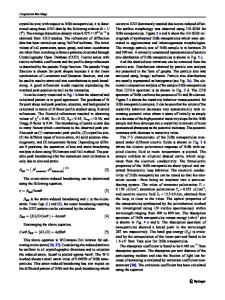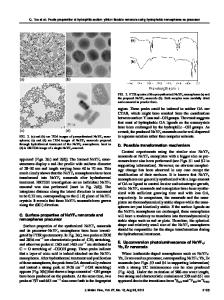Syntheses of Hydroxyapatite Nanospheres Through a Facile Sol-gel Method
- PDF / 1,279,815 Bytes
- 6 Pages / 612 x 792 pts (letter) Page_size
- 45 Downloads / 294 Views
1239-VV07-33
Syntheses of Hydroxyapatite Nanospheres Through a Facile Sol-gel Method
Kai Li and Sie Chin Tjong Department of Physics & Materials Science, City University of Hong Kong, Hong Kong
ABSTRACT
Hydroxyapatite (HA) nanospheres were synthesized via the sol-gel route in the presence of poly(vinyl alcohol) (PVA). The HA nanospheres were formed from the reaction between (NH4)2HPO4 and CaCl2 in ethanol/PVA sol-gel system, in which ammonia solution (NH3·H2O) was added to adjust the pH of solution. The as-synthesized products were characterized by means of X-ray diffraction (XRD), Fourier transform infrared spectroscopy (FTIR), thermogravimetric analysis (TGA), field emission scanning electron microscopy (FE-SEM) and energy-dispersive X-ray spectroscopy (EDAX). XRD patterns and FTIR spectra showed that the HA nanospheres exhibit the crystalline structure and vibration bands of HA. The Ca/P molar ratio of HA nanospheres (50~70 nm) approached the stoichiometric value of 1.67 on the basis of EDAX results. Simulated Body Fluid (SBF) immersion test for three weeks demonstrated that the apatite layer can be formed on the HA nanospheres sintered at 550 °C.
INTRODUCTION
Hydroxyapatite (HA) with the chemical composition of Ca10(PO4)6(OH)2 is the main mineral constituent of human bone tissues. Synthetic hydroxyapatite ceramic cannot be used as an implant material for load bearing application due to its low yield strength and fracture toughness. Synthetic HA has found main clinical applications as a coating material for metallic implants and the filler of polymer composites because of its excellent biocompatibility and bioactivity. For example, conventional HA-polyethylene composites requires the dispersion of a large amount (40 vol%) of HA micro-particles in the polymer matrix. However, such micro-composites can only be used as the implant materials for orbital floor prosthesis, middle ear implant and maxillofacial surgery applications due to their low mechanical strength [1,2]. As recognized, the mechanical strength of materials increases sharply by decreasing their grain sizes from micrometer down to nanometer regime. Recent advances in nanotechnology have led to the development of nano-structured materials with enhanced mechanical strength. Accordingly, nano-HA (nHA) with large surface area to volume ratio exhibits better mechanical performance than its micro-HA counterpart. Consequently extensive research efforts have been paid towards the nHA synthesis including co-precipitation, micelle template, mechanochemical and
hydrothermal processes [3-4]. However, these techniques have many limitations and unlikely to be used for large-scale practical production due to the complicated procedures involved and particulate aggregation. Recent studies showed the polymeric additives such as poly(lactic acid) (PLA), poly (ethylene glycol) (PEG), poly(vinyl alcohol) (PVA) etc. possess attractive components for forming nano-materials. The polar functional groups such as -COOH, -O- and -OH etc. are beneficial for nHA formation si
Data Loading...











